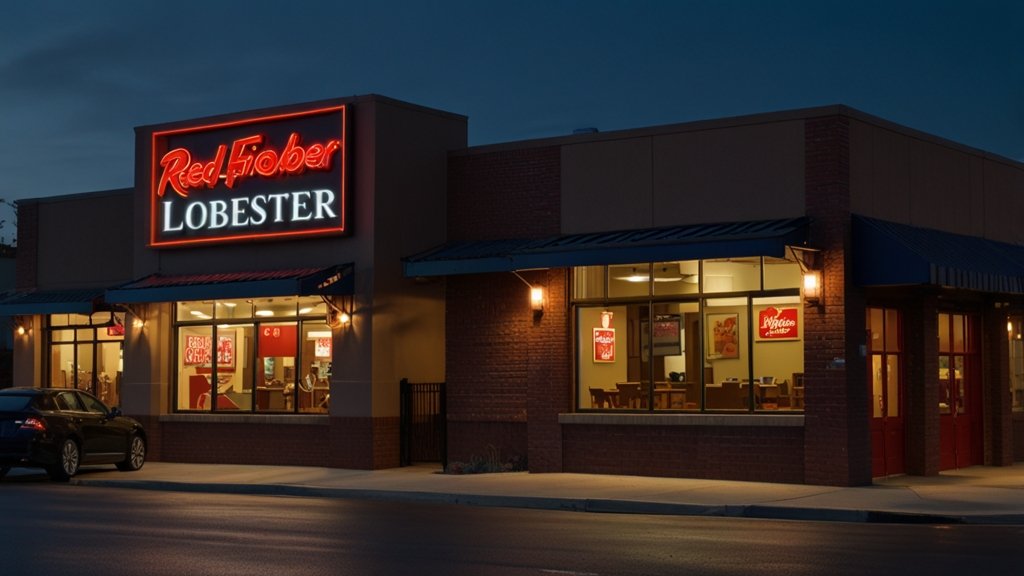Picture this: You pull into a familiar shopping center, craving those endless shrimp or maybe a loaded potato skin. But instead of the warm glow of the restaurant sign, you see darkened windows and a “For Lease” placard. It’s a scene playing out across America in 2025, as the unexpected news of Red Lobster TGI Fridays closing locations becomes a stark symbol of change. These aren’t isolated incidents; they represent a seismic shift in the landscape of casual dining, driven by forces reshaping where and how we eat.
The numbers tell a sobering story. Early in 2025, both Red Lobster and TGI Fridays embarked on massive waves of U.S. restaurant closures under Chapter 11 bankruptcy protection. Red Lobster streamlined its fleet from 578 locations down to approximately 544. TGI Fridays underwent an even more dramatic transformation, collapsing from roughly 270 corporate-owned outlets to a mere 85 by April 2025. These closures aren’t random misfortunes; they’re calculated survival moves in an industry battling relentless headwinds.
The Perfect Storm: Why Casual Dining Giants Are Shrinking
The pandemic was a catalyst, but the pressures facing chains like Red Lobster and TGI Fridays have only intensified since. It’s a complex recipe for contraction:
- The Inflation Squeeze: Soaring costs for food (especially seafood for Red Lobster), labor, and utilities have hammered profit margins. Menu price increases can only go so far before customers balk.
- Supply Chain Hangovers: Consistent access to key ingredients remains a challenge, disrupting operations and frustrating diners expecting reliability.
- The Evolving Consumer: Dining habits have fundamentally changed. Demand for convenience (delivery, takeout) boomed during lockdowns and remains high, often favoring fast-casual or digital-native brands over traditional sit-down experiences. Value perception is paramount, and many consumers are trading down or dining out less frequently.
- Overexpansion & Shifting Demographics: Some locations, opened in boom times, simply no longer fit the economic or demographic realities of their neighborhoods.
- Intense Competition: The market is saturated, with competitors ranging from other casual chains to fast-casual innovators and even grocery store meal kits offering convenience.
Chapter 11: Not Just an End, But a Strategic Restart
For both Red Lobster and TGI Fridays, Chapter 11 bankruptcy wasn’t just about closing doors; it was a strategic tool for radical restructuring. Key components of their plans included:
- Rejecting Unprofitable Leases: This is the primary driver behind the physical closures. Bankruptcy law allows companies to break free from long-term, costly leases for underperforming locations.
- Selling Real Estate to Franchisees: Both brands shifted ownership of select locations to franchise partners. This reduces corporate overhead and risk while leveraging franchisee local market expertise.
- Debt Reduction & Refinancing: Restructuring crippling debt loads to create a more sustainable financial foundation.
- Focusing on Core Markets: Exiting marginal areas to concentrate resources and marketing efforts where brand recognition and potential are strongest.
Also Read: Multi-Function Tools That Every Distribution Lineman Should Carry
Red Lobster vs. TGI Fridays: The 2025 Restructuring Snapshot
| Feature | Red Lobster | TGI Fridays |
|---|---|---|
| Pre-Bankruptcy Locations (US) | ~578 (Primarily corporate-owned) | ~270 (Corporate-owned segment) |
| Post-Restructuring Locations (US) | ~544 (Mix of corporate & franchise) | ~85 (Corporate-owned, significantly reduced) |
| Primary Restructuring Tool | Chapter 11 Bankruptcy | Chapter 11 Bankruptcy |
| Key Strategy | Lease rejections, sale-leasebacks, franchise expansion focus | Aggressive lease rejections, sale of corporate stores to franchisees |
| Magnitude of Reduction | ~34 Closures (Approx. 6% reduction) | ~185 Closures (Approx. 69% reduction of corporate footprint) |
| Stated Goal | Streamline for profitability, focus on strong markets | Create a more sustainable, franchise-led model |
Beyond Two Brands: A Broader Casual Dining Reckoning
The Red Lobster TGI Fridays closing wave is far from an isolated event. It underscores a profound recalibration happening across the casual dining sector:
- Footprint Rationalization: Major chains are critically evaluating every location. Unprofitable stores, especially those burdened by high rents, are unsustainable. Expect more closures from other players.
- The Franchise Model Ascendant: Companies are increasingly shifting away from owning and operating restaurants directly. Franchising transfers operational costs and real estate risk to local owners, creating a more asset-light corporate structure.
- Experience Evolution: Surviving chains must innovate. This means revamping menus for value and current tastes, investing heavily in seamless digital ordering and delivery integration, and enhancing the in-restaurant experience to justify dining out versus staying in.
- Value is King: In an inflationary environment, chains that fail to communicate and deliver compelling value propositions will continue to struggle. This doesn’t always mean the cheapest, but the best perceived quality and experience for the price.
What This Means for Diners and Communities
While the Red Lobster TGI Fridays closing news signifies corporate strategy, the impact is deeply local:
- Lost Gathering Spots: These restaurants were often community fixtures – places for birthdays, after-work drinks, or family celebrations. Their closure leaves a void.
- Job Losses: Each closure directly impacts employees – servers, cooks, managers – contributing to local economic strain.
- Shifting Options: Consumer choice diminishes in affected areas, potentially benefiting remaining competitors or independent restaurants.
- Focus on Survivors: The remaining locations of these chains (and others) will be under pressure to perform exceptionally well. Expect corporate investment to be concentrated here.
Looking Ahead: The Future of Casual Dining
The casual dining model isn’t dead, but it is evolving rapidly. The survivors of this current shakeout will likely be chains that:
- Master Omnichannel: Seamlessly blend in-restaurant, takeout, delivery, and catering.
- Offer Clear, Consistent Value: Whether through innovative menu engineering, loyalty programs, or strategic promotions.
- Embrace Operational Agility: Adapting menus and staffing to cost fluctuations and demand.
- Invest in the Experience: Differentiating through atmosphere, service, or unique offerings that can’t be easily replicated at home or by fast-casual.
- Maintain a Sustainable Footprint: Operating only in locations with proven viability, often with a heavier reliance on franchise partners.
The Red Lobster TGI Fridays closing headlines are a powerful reminder of how profoundly economic pressures and consumer preferences can reshape familiar industries. While the sight of a shuttered restaurant is always bittersweet, these closures represent necessary, albeit painful, steps towards a more sustainable future for these iconic brands and the casual dining sector as a whole. The journey to viability is ongoing, and adaptation remains the key ingredient for survival.
You May Also Read: The Rise of Rice Bran Oil in India: Market Trends & Demand
FAQs
Are all Red Lobster and TGI Fridays closing?
No, absolutely not. Both chains are closing underperforming locations. Red Lobster is operating about 544 US locations post-restructuring, and TGI Fridays still has roughly 85 corporate-owned US locations plus many international and domestic franchise locations not included in this specific closure count.
Why are Red Lobster and TGI Fridays closing so many locations?
The primary drivers are sustained high costs (food, labor, rent), shifting consumer dining habits favoring convenience and value, intense competition, and the strategic use of Chapter 11 bankruptcy to shed unprofitable leases and debt accumulated during difficult times.
How does Chapter 11 bankruptcy relate to the closures?
Chapter 11 allows companies to reorganize while operating. A key tool is “lease rejection,” enabling them to legally break leases for locations deemed unprofitable or too costly, leading directly to those specific closures. It also facilitates debt restructuring and selling assets.
Is my local Red Lobster or TGI Fridays safe from closing?
The safest locations are typically those with strong sales performance, favorable lease terms, and situated in high-demand areas. Corporate announcements sometimes list specific closures, but otherwise, it’s hard to predict individual fates without internal performance data. Franchised locations operate independently.
What is happening to the employees at the closing locations?
Unfortunately, permanent closures result in job losses for staff at those specific restaurants. Companies may offer severance or attempt to relocate employees to nearby open locations, but this isn’t always possible.
Will the food or experience change at the remaining locations?
Both brands are under pressure to improve profitability. This often leads to menu refinements (focusing on popular, profitable items, value bundles), potential price adjustments, and a push for operational efficiency. Enhancing the customer experience to drive traffic is also crucial.
What does this mean for the future of other big casual dining chains?
The Red Lobster TGI Fridays closing trend reflects broader industry challenges. Other major casual dining chains are likely evaluating their own footprints, potentially leading to more closures, increased franchising, menu innovation, and a heightened focus on value and off-premise dining (delivery/takeout) to stay competitive.











